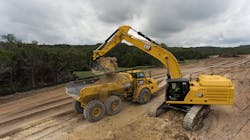Machine control cuts costs from infrastructure projects
By Eman Abu-Khaled, Editorial Intern
Professionals in the construction industry know that “There’s a price tag to every minute on a job site,” says Ashley Pittman, the GPS manager at Brent Scarbrough and Co. The need for the most reliably efficient and accurate methods is why fleets such as Scarbrough’s use machine control to reduce costs and improve performance.
The Infrastructure Investment and Jobs Act is releasing spending on projects from roads and bridges to sewers and broadband, creating a pipeline of projects. Ongoing inflationary pressures caused by supply chain shortages and interest rate increases will deeply cut the value and scope of infrastructure projects put in place.
As a result, the value of every dollar shrinks as the price tag on every minute of work grows. The pressure is on to increase productivity, accuracy, and efficiency while reducing costs.
GPS machine control allows contractors to understand and adjust to the worksite surface without the need for a surveyor. It provides better accuracy in necessary calculations in a shorter amount of time.
But machine control is only as smart as what it is told, according to Lonnie Fritz, senior market professional at Caterpillar.
“After the development of the 3D digital design file is complete, the file is uploaded to the machine’s machine control and guidance system,” Fritz says. “The alignment(s) and grade information for the job site are onboard and ready for operator intervention during machine operation. When the operator activates the machine control and guidance system, the design information is displayed showing the operator where to cut or fill to build to the project’s design.”
As Pittman says, time is money, and every mistake can be a painful blow that costs resources such as fuel. Unforeseen costs further eat into available infrastructure dollars, he says.
Scarbrough equips its crawler dozers with Trimble GPS machine control. The technology enables the machines to grade the site with an accurate data analysis. Machine-control grading saves time, Pittman says.
“You cannot put dirt in the wrong place and then have to take it back out,” he says.
Matt Goedert, solutions marketing manager, roadbuilding at John Deere, provided another example of time savings with GPS machine control.
“If we were grading a mile of two-lane highway, and let’s say the subgrade was…low just over a half inch, this would require roughly 450 tons of extra road base,” Goedert says. “Depending on where the aggregate is sourced and the price to transport, the added cost could range between $7,000-$10,000. If we use the same example for concrete, that’s over $27,000 in added concrete cost. Because materials make up the largest portion of the cost to complete road building jobs, machine control plays an important role in improving accuracy and minimizing waste of material.”
GPS has raised the stakes and competition standards.
“The most notable difference we see [using GPS] is the speed at which contractors can complete the job, as well as the increase in the quality of the finished product,” Goedert says. “The majority of this can be attributed to the adoption of technology by road building contractors.”
In such a competitive environment, according to Pittman, being quicker, more efficient, and delivering higher quality wins the bid. A recent project grading a ridge wall next to a Costco in Georgia illustrates.
“This one was basically just a mountain of granite that had to be worked out,” he says.
Pre-planning determined the need to build berms around the Costco building.
“They had all these berms pre-planned to look a certain way, because not only do you want to be able to store the excess material, you also want it to look decent,” he says. “And so we'd have to go in and reestablish different tops and toes on them to allow more material to be stored. And just the berms alone would have taken a very long time. In fact, I don't know if they ever could be correct…with survey stakes.”
Pittman says using GPS to calculate how deep to go saves time and improves the stability of the job site. With GPS, Pittman was able to save both time and value.
“The GPS allowed us to do it right the first time and not the hundredth time,” he says. “You just hit a button on the GPS and when it shows negative, you know okay, anything from here, it's got to be clean fill.”
A Trimble study to test how machine control affects accuracy included data from novice, intermediate, and expert operators. The results showed that a novice was able to perform grading with a 43-percent increase in accuracy using guidance-only machine control, and an average improvement of almost 52 percent when using automatic grade control.
Read also: Trimble studies show machine tech results
Not only did the novice perform the grading more accurately, but they were also almost 50 percent faster with guidance-only than conventional methods and more than 62 percent faster with automatics as compared to conventional methods. On average, novice operators were able to complete the job in a third of the time of conventional practices while staying well within required error tolerance.
Machine control address two major challenges facing fleets tasked with building projects funded by the IIJA: a critical labor shortage and skyrocketing inflation. Machine control improves operator performance, whether novice or experienced. Machine control boosts accuracy, and they saves time, resources, and labor.
